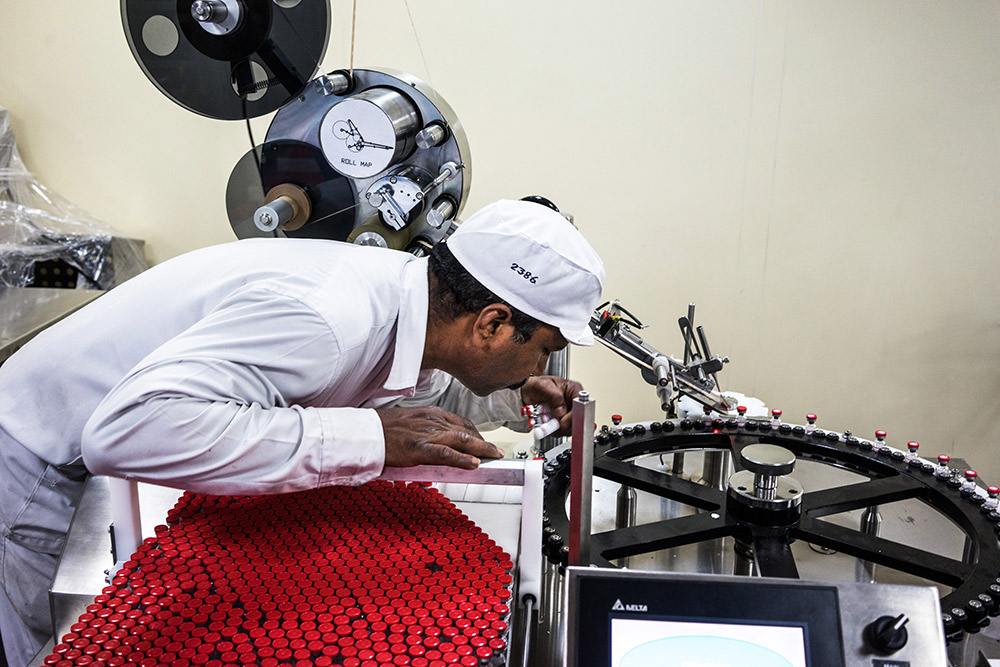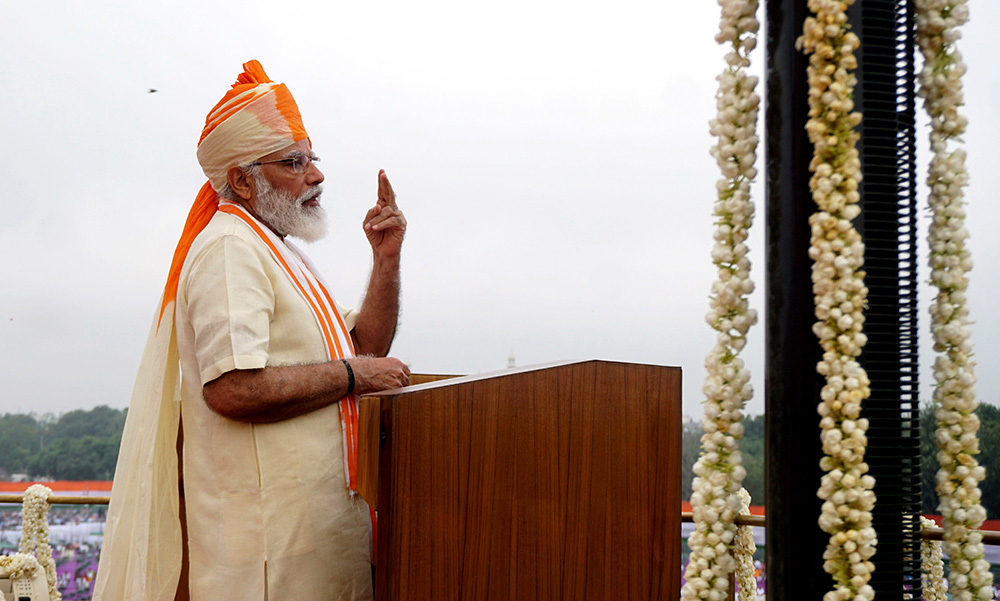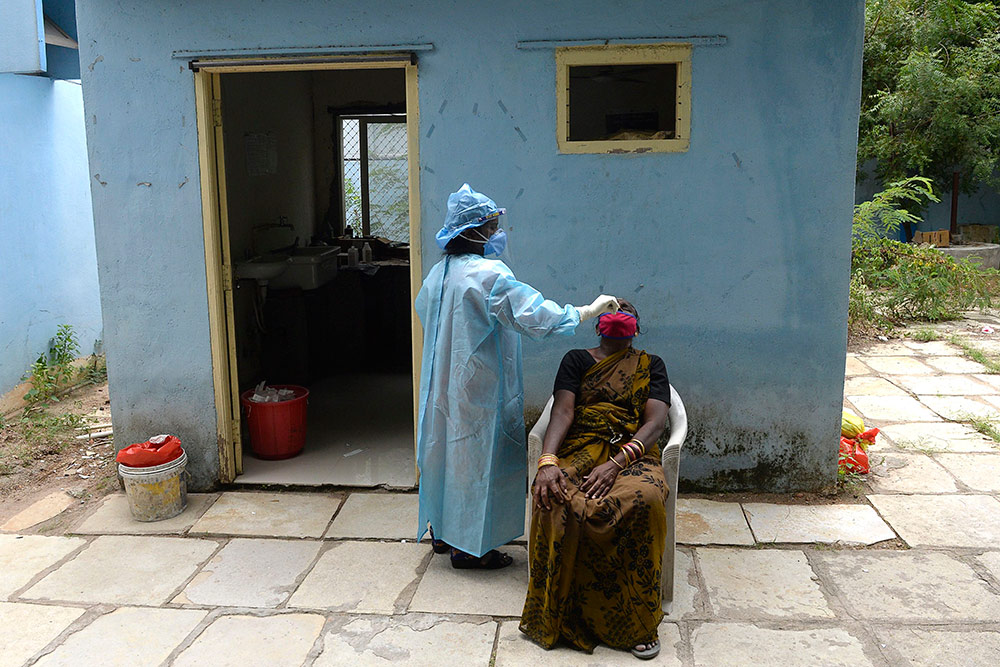印度向来有“世界药房”之称,这个绰号实至名归。这个世界第二人口大国是举足轻重的药品制造中心。有数据为证:在美国消费的每三颗药丸中就有一颗是在印度制造的。印度生产的疫苗占全球总供应量的一半以上,其生产的仿制药也比其他任何地方都多。
印度或许已经成为新冠疫苗生产的重要参与者。一家印度制药巨头正开始生产数亿剂处于领先地位的新冠疫苗。
但在这场对抗新冠病毒的竞赛中,印度的野心不止是充当世界制药工厂那么简单;它还希望驾驭科学的力量来终结这场疫情。至少有七家印度制药商正在研发疫苗,其中两家已进入人体试验阶段。印度总理纳伦德拉·莫迪将这一成就誉为国家的骄傲。
一种自主研发,并迅速推广的疫苗,对印度的重要性再强调也不过分,因为全国范围内的封锁措施未能阻止印度成为全球新冠病毒感染病例增长最快的国家。迄今为止,印度的新冠死亡病例超过68,000例,累计确诊病例超过390万例。
如果一家印度制药公司能够将新冠疫苗推向商业市场,它就有可能改变整个行业的声誉,并且让印度拥有一款在全球分销的疫苗。更重要的是,这种疫苗不仅是在印度制造或测试的,而且也是在印度研发的。
仿制药制造大国
印度制药业以生产仿制药而闻名于世。就疗效而言,这些仿制药与品牌药相同,但远没有那么昂贵,因为它们是在品牌药的专利过期后生产的。
1970年,为帮助印度摆脱对昂贵进口药的依赖,激励本国药企为亿万国民生产廉价药,印度政府策动了一系列法律改革,由此拉开了本国仿制药行业迅猛发展的序幕。一部新法律允许为生产工艺申请专利,但不允许为最终产品申请专利。在这部法律的激励下,印度制药企业开始竞相开发替代方法来生产现有药物。
15年后,随着美国通过的《哈奇-瓦克斯曼法案》放松了对仿制药的监管,这些改革被证明特别有先见之明。印度制药联盟秘书长苏达珊·贾恩指出,对于印度仿制药行业来说,这是一个“至关重要”的进展。这项法律使得仿制药制造商更容易进入美国市场,而印度早已为全球仿制药生产的加速发展做好了准备。
“到20世纪90年代,印度制药业已经非常发达,尤为擅长药品的制造环节。所以,无论哪一种新药问世,印度都有能力把它制造出来。”专业服务提供商普华永道公司印度制药业研究主管苏杰·谢蒂说。
如今,制药业为印度创造了250万个就业岗位。麦肯锡高级合伙人兼印度制药业务负责人萨提亚•普拉提帕蒂表示,制药业不仅对印度经济的发展贡献巨大,也是减少印度贸易逆差的第三大贡献者。

得益于廉价劳动力和大规模生产设施,在印度生产药品(包括疫苗在内)的成本相对较低。例如,印度制药巨头巴拉特生物技术公司生产一种轮状病毒疫苗,其成本仅为印度以外地区研发的轮状病毒疫苗的1 / 15。
以研究印度疫苗史著称的疫苗学家和公共卫生专家钱德拉坎特·拉哈里亚表示:“无论与世界上哪个地方相比,印度研发的新冠病毒疫苗都要便宜得多。”新冠疫苗的可负担性具有至关重要的意义:如果一剂疫苗昂贵得令人望而却步,就可能会妨碍分销,从而延长疫情的持续时间,并造成生命损失。
印度血清研究所是世界上最大的疫苗制造商。这个由家族掌管的私营药企成立于1966年,总部设在印度西部城市普纳。该公司正联合制药业巨头阿斯利康,生产由牛津大学研发的新冠疫苗,后者被一位世界卫生组织官员誉为世界上最先进的冠状病毒候选疫苗。血清研究所没有回应记者的置评请求。
据路透社8月25日报道,在印度和其他新兴经济体,血清研究所计划以每剂3美元的价格销售新冠疫苗。
相比之下,根据辉瑞和德国生物科技公司BioNTech SE与美国政府达成的疫苗出售协议,每剂疫苗的价格为19.5美元。另一家疫苗制造商莫德纳在今年8月表示,在一些交易中,其疫苗的定价在32至37美元之间。辉瑞的疫苗正在美国和德国生产;莫德纳正在美国和瑞士的工厂生产疫苗。
印度血清研究所首席执行官艾达尔·普纳瓦拉表示,一半的疫苗将投放在印度,另一半将销往世界其他地区,特别是贫穷国家。
“在开发方面很在行”
印度的药品制造能力举世无双,但制药商的研发能力却相形见绌。
病毒学家沙希德·贾梅尔指出:“这是一个大产业,这个产业不太热衷于研发新疫苗,它更专注于如何以一种非常划算的方式生产疫苗。”贾梅尔还担任惠康信托/DBT印度联盟的首席执行官。这是一家致力于资助印度生物医学和卫生研究的公共慈善机构。
新德里工业发展研究所副教授雷吉•K•约瑟夫专门研究专利和印度制药业。根据他提供的数据,印度制药业的整体研发支出约占总收入的6%,而全球制药公司的这一比例为20-25%。
例如,2019年阿斯利康的研发支出占销售额的26%。(约瑟夫表示,印度制药企业研发费用占销售收入比例较低的另一个原因是,劳动力和建筑施工等相关成本通常更低一些。)
许多印度公司只专注于仿制药,而那些在研发方面有投资的印度领先药企往往专注于开发和改进仿制药配方。相比之下,美国和欧洲的跨国公司更专注于为新药创造新的化学实体。
印度仿制药行业的非凡实力和傲人成功意味着,仿制药制造商没有那么大的动力去涉足风险更大、成本更高的新化学实体研究领域。
“大多数印度药企没有涉足新药的研发。这些企业仍然在生产仿制药,所以他们不需要在研发方面进行大量投资。”约瑟夫说。
“印度在D侧,也就是开发方面很在行。”谢蒂说,“它更像是渐进式创新,所以就广泛的创新或研究而言,规模相对较小。”
约瑟夫说,印度药企的研发支出增长缓慢,但技术和财力方面的约束也使得这项支出无法以更快的速度增长。“新药开发涉及大量投资,许多公司都无法维持足以跟欧美制药巨头相媲美的投资规模。”他说,“与西方的跨国公司相比,就连最大的印度制药商也只能算是小企业。”
在贾梅尔看来,通常情况下,重制造轻研发并不是印度制药业的缺点,但“印度药品研发领域从新冠疫情中学到的一大教训是,你必须拥有一个可以迅速转换用途的平台,帮助你为业已出现的新病原体制造疫苗。”贾梅尔说。
现有的疫苗平台反映了制药商此前对研究的投资。牛津大学利用现有的技术——黑猩猩腺病毒疫苗载体——来制造疫苗。作为另一家在全球新冠疫苗竞赛中处于领先地位的制药商,莫德纳公司利用其实验性的寨卡病毒mRNA疫苗平台开发候选疫苗。Zydus Cadila是致力于研发新冠疫苗的印度药企之一,它从零开始创建了实验性的DNA疫苗平台。印度另一家疫苗生产商巴拉特生物技术公司在Vero细胞平台上开发新冠疫苗。
三种候选疫苗
目前全球有37种潜在新冠疫苗正在进行人体试验,其中就包括Zydus Cadila和巴拉特研发的疫苗。
8月15日,莫迪在德里红堡的城墙上发表全国讲话时表示:“今天每个人都非常关注冠状病毒。每个人都想知道疫苗何时上市。我们的科学家正在不懈地努力。”

莫迪说:“印度正在测试的新冠疫苗不是一种,也不是两种,而是多达三种。”他指的是巴拉特和Zydus自主研发的疫苗,并且把血清研究所准备生产的阿斯利康—牛津疫苗也计算在内。
总部位于海德拉巴的巴拉特生物技术公司是一家知名的印度疫苗制造商,曾在2010年推出H1N1流感疫苗,并在2013年和2015年成功开发和推出了日本脑炎疫苗和轮状病毒疫苗。
目前,巴拉特正在与印度医学研究委员会、威斯康星大学麦迪逊分校的病毒学家和美国生物技术公司FluGen合作研发一种名为Covaxin的新冠疫苗。Covaxin是一种灭活疫苗,这意味着它含有新冠病毒的“死亡”颗粒,这些颗粒不再致病,但仍会促使接种者产生免疫反应。
据当地媒体报道,巴拉特在印度的12个地点对Covaxin疫苗进行了第一阶段试验,并且很可能从本月开始启动第二阶段试验。
“大部分的疫苗都来自西方世界。但我很高兴地告诉大家,相较于世界其他地方研发的疫苗,来自印度的这两种候选疫苗目前处于领先地位。”巴拉特生物技术公司联合董事总经理苏奇特拉·埃拉在7月30日告诉《印度时报》。
巴拉特拒绝置评。
8月6日,Zydus开始在印度的多个地点进行二期人体临床试验。其候选疫苗ZyCoV-D是一种基于DNA的疫苗。它包含被称为质粒的基因工程DNA分子,后者类似于新冠病毒的质粒。贾梅尔指出,灭活疫苗是最容易生产的,而DNA疫苗从未在世界任何地方获准在人体上使用。世界卫生组织称它是“一种全新的疫苗接种方法。”
Zydus的总部位于印度西部沿海城市,隶属于古吉拉特邦的艾哈迈达巴德市。它是印度最大的制药公司之一,也是一家大型仿制药制造商。这家公司还生产过一些获准销售的疫苗产品,其中包括一种季节性流感的免疫疫苗、一种水痘疫苗和一种狂犬病疫苗。Zydus没有回应记者的置评请求。
“我非常希望至少有一种疫苗能够产生立竿见影的效果,如果这两种疫苗都获得成功的话,我们就会挑花眼的。”贾梅尔说。
每个国家只顾自己?
随着疫苗持续蔓延,世界各地的科学家竞相开发安全有效的治疗方法,一些专家表达了对“疫苗民族主义”的担忧,即各国在开发疫苗时,首先考虑的是给本国公民接种,而不是致力于造福全球民众。

印度政府尚未与其国内疫苗制造商达成正式采购协议,但在8月中旬,一个政府委员会召见了三家正在印度进行人体试验的疫苗制造商,讨论潜在的分销协议,并寻求了解疫苗生产进度和出售价格。
血清研究所首席执行官普纳瓦拉告诉《纽约时报》,尽管他计划将该公司生产的一半疫苗分发给世界各地的贫穷国家,但印度政府“仍然有可能选择他们认为合适的时机,以本国事态紧急为由,调用这些疫苗。”
印度政府此前曾禁止制药商出口可能有助于治疗新冠肺炎的药物,此举据称是为了确保本国公民能够获得这些药物。(政府后来取消了这项禁令。)到目前为止,印度政府还没有公开反对血清研究所的疫苗分销计划。
公共卫生专家拉哈里亚表示,由世卫组织和流行病防范创新联盟等机构领导的全球合作机制将在全球疫苗分配,以及为穷国储备疫苗方面发挥重要作用。但与此同时,他补充道,“目前已经形成了一种共识——如果任何一个国家开发出了疫苗,他们当然会把其中相当大一部分留在本国。”(财富中文网)
译者:任文科
印度向来有“世界药房”之称,这个绰号实至名归。这个世界第二人口大国是举足轻重的药品制造中心。有数据为证:在美国消费的每三颗药丸中就有一颗是在印度制造的。印度生产的疫苗占全球总供应量的一半以上,其生产的仿制药也比其他任何地方都多。
印度或许已经成为新冠疫苗生产的重要参与者。一家印度制药巨头正开始生产数亿剂处于领先地位的新冠疫苗。
但在这场对抗新冠病毒的竞赛中,印度的野心不止是充当世界制药工厂那么简单;它还希望驾驭科学的力量来终结这场疫情。至少有七家印度制药商正在研发疫苗,其中两家已进入人体试验阶段。印度总理纳伦德拉·莫迪将这一成就誉为国家的骄傲。
一种自主研发,并迅速推广的疫苗,对印度的重要性再强调也不过分,因为全国范围内的封锁措施未能阻止印度成为全球新冠病毒感染病例增长最快的国家。迄今为止,印度的新冠死亡病例超过68,000例,累计确诊病例超过390万例。
如果一家印度制药公司能够将新冠疫苗推向商业市场,它就有可能改变整个行业的声誉,并且让印度拥有一款在全球分销的疫苗。更重要的是,这种疫苗不仅是在印度制造或测试的,而且也是在印度研发的。
仿制药制造大国
印度制药业以生产仿制药而闻名于世。就疗效而言,这些仿制药与品牌药相同,但远没有那么昂贵,因为它们是在品牌药的专利过期后生产的。
1970年,为帮助印度摆脱对昂贵进口药的依赖,激励本国药企为亿万国民生产廉价药,印度政府策动了一系列法律改革,由此拉开了本国仿制药行业迅猛发展的序幕。一部新法律允许为生产工艺申请专利,但不允许为最终产品申请专利。在这部法律的激励下,印度制药企业开始竞相开发替代方法来生产现有药物。
15年后,随着美国通过的《哈奇-瓦克斯曼法案》放松了对仿制药的监管,这些改革被证明特别有先见之明。印度制药联盟秘书长苏达珊·贾恩指出,对于印度仿制药行业来说,这是一个“至关重要”的进展。这项法律使得仿制药制造商更容易进入美国市场,而印度早已为全球仿制药生产的加速发展做好了准备。
“到20世纪90年代,印度制药业已经非常发达,尤为擅长药品的制造环节。所以,无论哪一种新药问世,印度都有能力把它制造出来。”专业服务提供商普华永道公司印度制药业研究主管苏杰·谢蒂说。
如今,制药业为印度创造了250万个就业岗位。麦肯锡高级合伙人兼印度制药业务负责人萨提亚•普拉提帕蒂表示,制药业不仅对印度经济的发展贡献巨大,也是减少印度贸易逆差的第三大贡献者。
得益于廉价劳动力和大规模生产设施,在印度生产药品(包括疫苗在内)的成本相对较低。例如,印度制药巨头巴拉特生物技术公司生产一种轮状病毒疫苗,其成本仅为印度以外地区研发的轮状病毒疫苗的1 / 15。
以研究印度疫苗史著称的疫苗学家和公共卫生专家钱德拉坎特·拉哈里亚表示:“无论与世界上哪个地方相比,印度研发的新冠病毒疫苗都要便宜得多。”新冠疫苗的可负担性具有至关重要的意义:如果一剂疫苗昂贵得令人望而却步,就可能会妨碍分销,从而延长疫情的持续时间,并造成生命损失。
印度血清研究所是世界上最大的疫苗制造商。这个由家族掌管的私营药企成立于1966年,总部设在印度西部城市普纳。该公司正联合制药业巨头阿斯利康,生产由牛津大学研发的新冠疫苗,后者被一位世界卫生组织官员誉为世界上最先进的冠状病毒候选疫苗。血清研究所没有回应记者的置评请求。
据路透社8月25日报道,在印度和其他新兴经济体,血清研究所计划以每剂3美元的价格销售新冠疫苗。
相比之下,根据辉瑞和德国生物科技公司BioNTech SE与美国政府达成的疫苗出售协议,每剂疫苗的价格为19.5美元。另一家疫苗制造商莫德纳在今年8月表示,在一些交易中,其疫苗的定价在32至37美元之间。辉瑞的疫苗正在美国和德国生产;莫德纳正在美国和瑞士的工厂生产疫苗。
印度血清研究所首席执行官艾达尔·普纳瓦拉表示,一半的疫苗将投放在印度,另一半将销往世界其他地区,特别是贫穷国家。
“在开发方面很在行”
印度的药品制造能力举世无双,但制药商的研发能力却相形见绌。
病毒学家沙希德·贾梅尔指出:“这是一个大产业,这个产业不太热衷于研发新疫苗,它更专注于如何以一种非常划算的方式生产疫苗。”贾梅尔还担任惠康信托/DBT印度联盟的首席执行官。这是一家致力于资助印度生物医学和卫生研究的公共慈善机构。
新德里工业发展研究所副教授雷吉•K•约瑟夫专门研究专利和印度制药业。根据他提供的数据,印度制药业的整体研发支出约占总收入的6%,而全球制药公司的这一比例为20-25%。
例如,2019年阿斯利康的研发支出占销售额的26%。(约瑟夫表示,印度制药企业研发费用占销售收入比例较低的另一个原因是,劳动力和建筑施工等相关成本通常更低一些。)
许多印度公司只专注于仿制药,而那些在研发方面有投资的印度领先药企往往专注于开发和改进仿制药配方。相比之下,美国和欧洲的跨国公司更专注于为新药创造新的化学实体。
印度仿制药行业的非凡实力和傲人成功意味着,仿制药制造商没有那么大的动力去涉足风险更大、成本更高的新化学实体研究领域。
“大多数印度药企没有涉足新药的研发。这些企业仍然在生产仿制药,所以他们不需要在研发方面进行大量投资。”约瑟夫说。
“印度在D侧,也就是开发方面很在行。”谢蒂说,“它更像是渐进式创新,所以就广泛的创新或研究而言,规模相对较小。”
约瑟夫说,印度药企的研发支出增长缓慢,但技术和财力方面的约束也使得这项支出无法以更快的速度增长。“新药开发涉及大量投资,许多公司都无法维持足以跟欧美制药巨头相媲美的投资规模。”他说,“与西方的跨国公司相比,就连最大的印度制药商也只能算是小企业。”
在贾梅尔看来,通常情况下,重制造轻研发并不是印度制药业的缺点,但“印度药品研发领域从新冠疫情中学到的一大教训是,你必须拥有一个可以迅速转换用途的平台,帮助你为业已出现的新病原体制造疫苗。”贾梅尔说。
现有的疫苗平台反映了制药商此前对研究的投资。牛津大学利用现有的技术——黑猩猩腺病毒疫苗载体——来制造疫苗。作为另一家在全球新冠疫苗竞赛中处于领先地位的制药商,莫德纳公司利用其实验性的寨卡病毒mRNA疫苗平台开发候选疫苗。Zydus Cadila是致力于研发新冠疫苗的印度药企之一,它从零开始创建了实验性的DNA疫苗平台。印度另一家疫苗生产商巴拉特生物技术公司在Vero细胞平台上开发新冠疫苗。
三种候选疫苗
目前全球有37种潜在新冠疫苗正在进行人体试验,其中就包括Zydus Cadila和巴拉特研发的疫苗。
8月15日,莫迪在德里红堡的城墙上发表全国讲话时表示:“今天每个人都非常关注冠状病毒。每个人都想知道疫苗何时上市。我们的科学家正在不懈地努力。”
莫迪说:“印度正在测试的新冠疫苗不是一种,也不是两种,而是多达三种。”他指的是巴拉特和Zydus自主研发的疫苗,并且把血清研究所准备生产的阿斯利康—牛津疫苗也计算在内。
总部位于海德拉巴的巴拉特生物技术公司是一家知名的印度疫苗制造商,曾在2010年推出H1N1流感疫苗,并在2013年和2015年成功开发和推出了日本脑炎疫苗和轮状病毒疫苗。
目前,巴拉特正在与印度医学研究委员会、威斯康星大学麦迪逊分校的病毒学家和美国生物技术公司FluGen合作研发一种名为Covaxin的新冠疫苗。Covaxin是一种灭活疫苗,这意味着它含有新冠病毒的“死亡”颗粒,这些颗粒不再致病,但仍会促使接种者产生免疫反应。
据当地媒体报道,巴拉特在印度的12个地点对Covaxin疫苗进行了第一阶段试验,并且很可能从本月开始启动第二阶段试验。
“大部分的疫苗都来自西方世界。但我很高兴地告诉大家,相较于世界其他地方研发的疫苗,来自印度的这两种候选疫苗目前处于领先地位。”巴拉特生物技术公司联合董事总经理苏奇特拉·埃拉在7月30日告诉《印度时报》。
巴拉特拒绝置评。
8月6日,Zydus开始在印度的多个地点进行二期人体临床试验。其候选疫苗ZyCoV-D是一种基于DNA的疫苗。它包含被称为质粒的基因工程DNA分子,后者类似于新冠病毒的质粒。贾梅尔指出,灭活疫苗是最容易生产的,而DNA疫苗从未在世界任何地方获准在人体上使用。世界卫生组织称它是“一种全新的疫苗接种方法。”
Zydus的总部位于印度西部沿海城市,隶属于古吉拉特邦的艾哈迈达巴德市。它是印度最大的制药公司之一,也是一家大型仿制药制造商。这家公司还生产过一些获准销售的疫苗产品,其中包括一种季节性流感的免疫疫苗、一种水痘疫苗和一种狂犬病疫苗。Zydus没有回应记者的置评请求。
“我非常希望至少有一种疫苗能够产生立竿见影的效果,如果这两种疫苗都获得成功的话,我们就会挑花眼的。”贾梅尔说。
每个国家只顾自己?
随着疫苗持续蔓延,世界各地的科学家竞相开发安全有效的治疗方法,一些专家表达了对“疫苗民族主义”的担忧,即各国在开发疫苗时,首先考虑的是给本国公民接种,而不是致力于造福全球民众。
印度政府尚未与其国内疫苗制造商达成正式采购协议,但在8月中旬,一个政府委员会召见了三家正在印度进行人体试验的疫苗制造商,讨论潜在的分销协议,并寻求了解疫苗生产进度和出售价格。
血清研究所首席执行官普纳瓦拉告诉《纽约时报》,尽管他计划将该公司生产的一半疫苗分发给世界各地的贫穷国家,但印度政府“仍然有可能选择他们认为合适的时机,以本国事态紧急为由,调用这些疫苗。”
印度政府此前曾禁止制药商出口可能有助于治疗新冠肺炎的药物,此举据称是为了确保本国公民能够获得这些药物。(政府后来取消了这项禁令。)到目前为止,印度政府还没有公开反对血清研究所的疫苗分销计划。
公共卫生专家拉哈里亚表示,由世卫组织和流行病防范创新联盟等机构领导的全球合作机制将在全球疫苗分配,以及为穷国储备疫苗方面发挥重要作用。但与此同时,他补充道,“目前已经形成了一种共识——如果任何一个国家开发出了疫苗,他们当然会把其中相当大一部分留在本国。”(财富中文网)
译者:任文科
India is known as "the pharmacy of the world," and the nickname is well-deserved. The second-most populous country is a drug manufacturing powerhouse. One in three pills consumed in the U.S. is made in India. Its factories churn out more than half the globe's total vaccine supply and produce more generic drugs than anywhere else.
Already, India is likely to be an essential player in the manufacturing of a COVID-19 vaccine. One of the country's pharmaceutical giants is starting to produce hundreds of millions of doses of a leading contender.
But in the race to defeat the coronavirus, India wants to do more than be the world's workhorse; it also wants to harness science to bring the pandemic to an end. At least seven Indian pharmaceutical companies are working to develop a vaccine and two have progressed to human trials, an achievement Prime Minister Narendra Modi has touted as a source of national pride.
An indigenously-developed vaccine with a rapid rollout could be crucial for India, where nationwide lockdowns failed to prevent India from becoming the country with the fastest-growing number of coronavirus cases in the world, with over 68,000 deaths and more than 3.9 million confirmed infections.
If an Indian pharmaceutical company is able to bring a COVID-19 vaccine to the commercial market, it could transform the industry's reputation, giving India a globally-distributed coronavirus vaccine that's not just made or tested in India, but developed there, too.
Generic expertise
India's pharmaceutical industry is best known for producing generic drugs, which are identical to brand-name drugs but less expensive because they're made after the patent on the branded version has expired.
A government push in 1970 to wean India off costly imports and manufacture cheaper medicines for its own citizens led to legal reforms that kickstarted growth of India's generics industry. A new law allowed patents on manufacturing processes, but not the end product, which incentivized Indian pharmaceutical firms to develop alternate ways to produce existing drugs.
Those reforms proved especially prescient a decade and a half later, when the U.S. Hatch-Waxman Act relaxed generic drug regulation in the U.S., a "crucial" development for India's generic industry, said Sudarshan Jain, secretary-general of the Indian Pharmaceutical Alliance. The law made it easier for generic drugmakers to enter the U.S., and India was well-positioned for the resulting ramp-up of generic drug production worldwide.
"By the time you got to the 1990s you already had a very...well-developed pharmaceutical industry, which was very good at the manufacturing side of producing drugs. So literally anything that was out there, India was capable of making those combinations," said Sujay Shetty, India pharmaceuticals leader for professional services firm PricewaterhouseCoopers.
Today, the pharmaceutical sector is responsible for 2.5 million jobs in India. It's a significant contributor to GDP and the third-largest contributor to reducing India's trade deficit, said Sathya Prathipati, senior partner and leader of the pharma practice in India for McKinsey.
An employee checks a vaccine vial labeling machine at a Serum Institute of India pharmaceutical plant in Pune, India in 2015. The Institute working with AstraZeneca to produce a COVID-19 vaccine developed by Oxford.
Sanjit Das/Bloomberg via Getty Images
The cost of producing drugs, including vaccines, in India is relatively low because of cheaper labor and the nation's large-scale manufacturing facilities. A rotavirus vaccine by Indian pharma giant Bharat Biotech, for example, cost one-fifteenth as much as rotavirus vaccines developed outside of India.
"A [coronavirus] vaccine developed in India would be far cheaper than a vaccine developed anywhere else," said Chandrakant Lahariya, a vaccinologist and public health expert who has published research on the history of vaccines in India. The affordability of a COVID-19 vaccine is paramount; if doses are prohibitively expensive, it could hamper distribution, prolonging the pandemic and costing lives.
The largest vaccine maker in the world is the Serum Institute of India, a private family-run drug company founded in 1966 and headquartered in the western Indian city of Pune. It's partnered with pharmaceutical giant AstraZeneca to produce the Oxford University COVID-19 vaccine, which a World Health Organization (WHO) official dubbed the world's most advanced coronavirus vaccine candidate. The company did not respond to a request for comment.
Serum plans to price one dose at $3 for India and other emerging economies, Reuters reported on Aug. 25.
In comparison, Pfizer and German biotech firm BioNTech SE made a deal with the U.S. government to charge $19.50 per vaccine dose, and Moderna said in August it is charging between $32 and $37 in some deals for its vaccine. The Pfizer vaccine is being manufactured in the U.S. and Germany; Moderna’s vaccine is being manufactured at sites in the U.S. and Switzerland.
Serum chief executive Adar Poonawalla has said half the doses will go to India and the other half will go to the rest of the world, especially poorer countries.
'Very good at the D side'
India's drug manufacturing prowess is unparalleled, but its pharmaceutical research and development (R&D) lags behind by comparison.
"It's a big industry and the industry is less into research to develop new vaccines, it's more geared towards producing ... vaccines in a very cost-effective manner," said Shaheed Jameel, a virologist and chief executive officer of the Wellcome Trust/DBT India Alliance, a public charity that funds biomedical and health research in India.
India's pharmaceutical industry as a whole spends around 6% of total earnings on R&D, versus 20-25% among global pharmaceutical firms, said Reji K. Joseph, an associate professor at the Institute for Studies in Industrial Development in New Delhi who researches patents and India's pharmaceutical industry.
For example, R&D spending as a percentage of sales was 26% for AstraZeneca in 2019. (Firms in India also spend a smaller share of their revenue on R&D because related costs like labor and building construction are generally cheaper, according to Joseph.)
Many Indian firms focus exclusively on generics; the leading Indian firms that do invest in R&D tend to focus on developing and improving on generic drug formulas. Multinationals in the U.S. and Europe, meanwhile, tend to focus on creating new chemical entities for new drugs.
The strength and success of India's generics industry has meant that there isn't as much incentive for generic drugmakers to diversify into riskier—and more expensive—research of new chemical entities.
"Most companies [in India] have not ventured into the development of new medicines. They are still in the production of generics...so they don't need to invest heavily in R&D," Joseph said.
"India's very good at the D side, the development side," Shetty said. "It's more like incremental innovation, so in terms of broad innovation or [research], it's relatively small."
R&D expenditure is increasing slowly, Joseph said, but technological and financial constraints have kept it from growing at a faster pace. "The development of new drugs involves a lot of investment and [many] companies cannot sustain such investments" on the scale of American and European pharmaceutical giants, he said. "Even the largest Indian firm is small compared to western [multinational corporations]."
Normally, said Jameel, the emphasis on manufacturing over R&D isn't a drawback for India's pharmaceutical industry, but "one lesson that Indian R&D is learning from [the coronavirus pandemic] is that you must have platforms that you can very quickly repurpose to make vaccines for a new pathogen that has emerged," Jameel said.
Having existing vaccine platforms reflects prior investment in research. Oxford used existing technology, a chimpanzee adenovirus vaccine vector, to make its vaccine. Moderna, another global frontrunner for a coronavirus vaccine, made use of its experimental zika virus mRNA vaccine platform to develop its vaccine candidate. Zydus Cadila, one of the Indian companies working on a COVID-19 vaccine, created its experimental DNA vaccine platform from scratch; Bharat Biotech, another Indian vaccine player, developed its coronavirus vaccine on a Vero-cell platform.
Three vaccine contenders
The Zydus Cadila and Bharat Biotech vaccine candidates are two of 37 potential coronavirus vaccines currently undergoing human trials around the world.
"Everybody today is concerned about coronavirus. Everyone wants to know when the vaccine will be available. Our scientists are working tirelessly." Modi said in a national address on the ramparts of Delhi's Red Fort on Aug. 15.
Indian Prime Minister Narendra Modi discussed coronavirus vaccine candidates in a national address on India's 74th Independence Day on Aug. 15 in Delhi.
(Xinhua/via Getty Images)
"Not one, not two, as many as three coronavirus vaccines are being tested in India," Modi said, referring to the vaccines indigenously developed by Bharat and Zydus. He also counted in his tally the AstraZeneca-Oxford vaccine that the Serum Institute is set to manufacture.
Bharat Biotech, based in Hyderabad, is a known commodity in India's vaccine sector, having launched an H1N1 influenza vaccine in 2010 and successfully developed and launched vaccines for Japanese encephalitis in 2013 and rotavirus in 2015.
For its coronavirus vaccine, called Covaxin, it's collaborating with the Indian Council of Medical Research, University of Wisconsin-Madison virologists and U.S. biotech firm FluGen. Covaxin is an inactivated vaccine, meaning it contains "dead" particles of the coronavirus, SARS-CoV-2, that are no longer disease-producing, but will still prompt an immune response from the inoculated person.
Bharat conducted phase one trials of Covaxin across 12 sites in India, and will likely start phase two trials this month, according to local media reports.
"Most of the vaccines come from the Western world. But I am happy to share that the two vaccine candidates from India are actually in the lead with the rest of the world," Suchitra Ella, joint managing director of Bharat Biotech, told the Times of India on July 30.
Bharat Biotech declined to comment.
Zydus started its phase 2 human clinical trials on Aug. 6 at multiple sites across India. Its vaccine candidate, ZyCoV-D, is a DNA-based vaccine. It contains genetically-engineered DNA molecules called plasmids that resemble those of the coronavirus. Inactivated vaccines are the easiest to make, while DNA vaccines—which the WHO describes as a "radically new approach to vaccination"—have never been approved for human use anywhere in the world, Jameel said.
Headquartered in Ahmedabad, a city in the western coastal state of Gujarat, Zydus is one of India's biggest pharmaceutical companies and a large generic drugs manufacturer. It also has a track record of vaccine winners, including an immunization for a seasonal influenza, one for chickenpox, and one for rabies. Zydus did not respond to request for comment.
"I'm very hopeful that at least one, if not both of these will do well, and if that happens then we'll be spoiled for choice," Jameel said.
Every country for itself?
As the pandemic wears on and scientists around the world race to develop a safe and effective cure, some experts have expressed a fear of 'vaccine nationalism'—of countries developing vaccines with an eye to inoculate their own citizens first, rather than working towards global distribution.
A health worker collects a swab sample from a woman to test for the coronavirus at a primary health center in Hyderabad on Sept. 4, 2020.
(Photo by NOAH SEELAM/AFP via Getty Images)
India’s government hasn't yet struck official procurement deals with its domestic vaccine makers, but in mid-August, a government committee met with the three firms whose vaccines are undergoing human trials in India, to discuss a potential distribution deal and find out how soon, and at what price, the firms can produce vaccine doses.
Serum's Poonawalla told the New York Times that although he plans to send half of the Serum-produced vaccines to poorer countries around the world, India's government "may still invoke some kind of emergency if they deem fit or if they want to."
India's government has previously blocked companies from exporting potential COVID-19 treatment drugs, reportedly to ensure Indian citizens had access to the medications. (The government later lifted the restrictions.) So far, India's government has not objected to Serum's distribution plan.
Global collaborations led by agencies like the WHO and the Coalition for Epidemic Preparedness Innovations will play an important role in global vaccine distribution and stockpiling doses for poorer countries, Lahariya said. At the same time, he added, "There's already a sort of consensus developing that if any country develops a vaccine, of course they'll keep a higher proportion for within their country."






